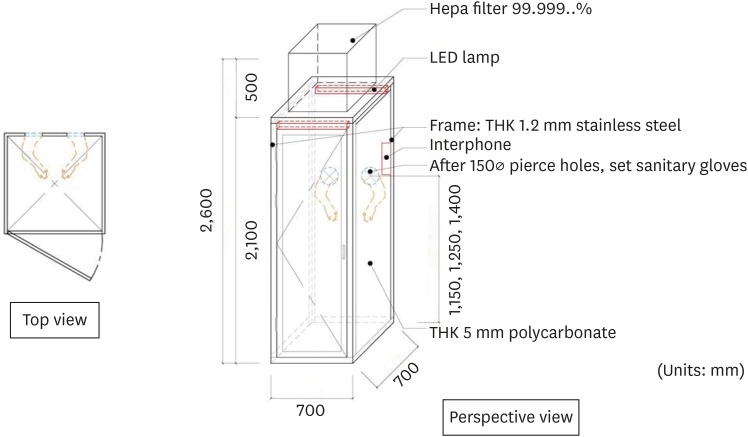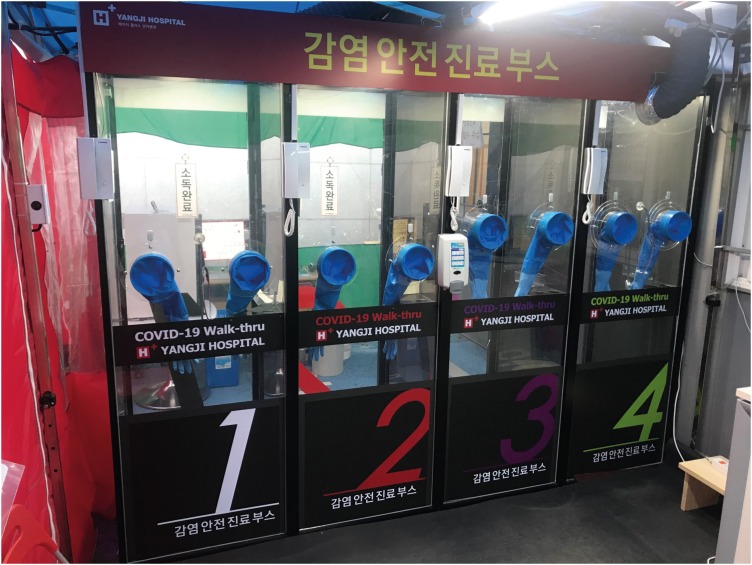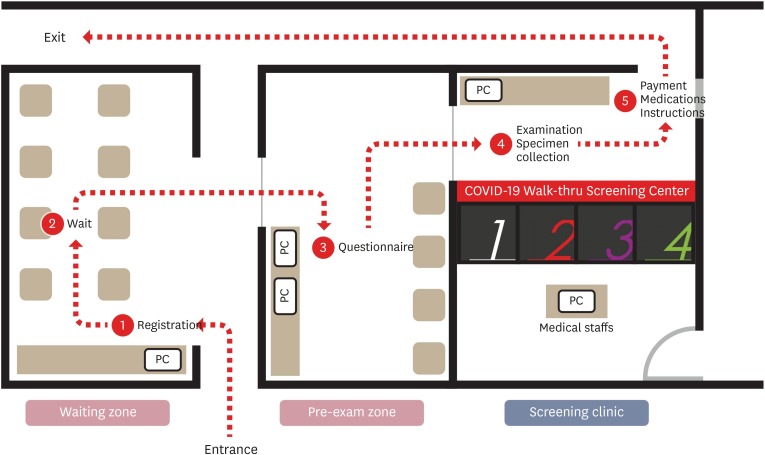Walk-Through Screening Center for COVID-19: an Accessible and Efficient Screening System in a Pandemic Situation
- Affiliations
-
- 1Department of Internal Medicine, H Plus Yangji Hospital, Seoul, Korea
- 2Division of Infectious Disease, Department of Internal Medicine, H Plus Yangji Hospital, Seoul, Korea
- KMID: 2500196
- DOI: http://doi.org/10.3346/jkms.2020.35.e154
Abstract
- With the ongoing novel coronavirus disease 2019 (COVID-19) pandemic, the number of individuals that need to be tested for COVID-19 has been rapidly increasing. A walk-through (WT) screening center using negative pressure booths that is inspired by the biosafety cabinet has been designed and implemented in Korea for easy screening of COVID-19 and for safe and efficient consultation for patients with fever or respiratory symptoms. Here, we present the overall concept, advantages, and limitations of the COVID-19 WT screening center. The WT center increases patient access to the screening clinics and adequately protects healthcare personnel while reducing the consumption of personal protective equipment. It can also increase the number of people tested by 9–10 fold. However, there is a risk of cross-infection at each stage of screening treatment, including the booths, and adverse reactions with disinfection of the booths. These limitations can be overcome using mobile technology and increasing the number of booths to reduce congestion inside the center, reducing booth volume for sufficient and rapid ventilation, and using an effective, harmless, and certified environmental disinfectant. A WT center can be implemented in other institutions and countries and modified depending on local needs to cope with the COVID-19 pandemic.
Keyword
Figure
Cited by 6 articles
-
Fast Screening Systems for COVID-19
Sungmin Kym
J Korean Med Sci. 2020;35(15):e153. doi: 10.3346/jkms.2020.35.e153.COVID-19 Screening Center: How to Balance between the Speed and Safety?
Jacob Lee
J Korean Med Sci. 2020;35(15):e157. doi: 10.3346/jkms.2020.35.e157.Letter to the Editor: How Did We Solve the Risk of Cross-Infection after Testing by the Walk-Through System Pointed Out by Many Authors?
Sang Il Kim, Ji Yong Lee
J Korean Med Sci. 2020;35(16):e162. doi: 10.3346/jkms.2020.35.e162.A Systematic Narrative Review of Comprehensive Preparedness Strategies of Healthcare Resources for a Large Resurgence of COVID-19 Nationally, with Local or Regional Epidemics: Present Era and Beyond
Young Kyung Yoon, Jacob Lee, Sang Il Kim, Kyong Ran Peck
J Korean Med Sci. 2020;35(44):e387. doi: 10.3346/jkms.2020.35.e387.The Higher Incidence of COVID-19 in Patients With Non-Tuberculous Mycobacterial Pulmonary Disease: A Single Center Experience in Korea
Sang Hyuk Kim, Byung Woo Jhun, Byeong-Ho Jeong, Hye Yun Park, Hojoong Kim, O Jung Kwon, Sun Hye Shin
J Korean Med Sci. 2022;37(32):e250. doi: 10.3346/jkms.2022.37.e250.Are We Truly Safe? Unfolding the Final Chapters of COVID-19 Walk-Through Booths
Su Ha Han, Minji Jung, Heon-Jae Jeong, JinKwan Hong
J Korean Med Sci. 2023;38(34):e290. doi: 10.3346/jkms.2023.38.e290.
Reference
-
1. World Health Organization. Coronavirus disease 2019 (COVID-19) Situation Report – 56. Updated 2020. Accessed March 16, 2020. https://www.who.int/docs/default-source/coronaviruse/situation-reports/20200316-sitrep-56-covid-19.pdf?sfvrsn=9fda7db2_6.2. Kwon KT, Ko JH, Shin H, Sung M, Kim JY. Drive-through screening center for COVID-19: a safe and efficient screening system against massive community outbreak. J Korean Med Sci. 2020; 35(11):e123. PMID: 32193904.
Article3. Korea Statistics. Population census. Updated 2020. Accessed April 2, 2020. http://kosis.kr/statisticsList/statisticsListIndex.do?menuId=M_01_01&vwcd=MT_ZTITLE&parmTabId=M_01_01#SelectStatsBoxDiv.4. Jensen PA, Lambert LA, Iademarco MF, Ridzon R; CDC. Guidelines for preventing the transmission of Mycobacterium tuberculosis in health-care settings, 2005. MMWR Recomm Rep. 2005; 54(RR-17):1–141.5. Centers for Disease Control and Prevention. Interim infection prevention and control recommendations for patients with suspected or confirmed coronavirus disease 2019 (COVID-19) in healthcare settings. Updated 2020. Accessed March 23, 2020. https://www.cdc.gov/coronavirus/2019-ncov/infection-control/control-recommendations.html.6. World Health Organization. Infection prevention and control during health care when novel coronavirus (nCoV) infection is suspected. Interim guidance. Updated 2020. Accessed March 25, 2020. https://www.who.int/publications-detail/infection-prevention-and-control-during-health-care-when-novel-coronavirus-(ncov)-infection-is-suspected-20200125.7. Centers for Disease Control and Prevention. Updated 2020. Accessed March 20, 2020. http://ncov.mohw.go.kr/searchBoardView.do?brdId=2&brdGubun=25&dataGubun=&ncvContSeq=1085.8. Centers for Disease Control and Prevention. Updated 2020. Accessed March 25, 2020. https://www.cdc.go.kr/board/board.es?mid=a20507020000&bid=0019.9. United states Environmental Protection Agency. List N: disinfectants for use against SARS-CoV-2. Updated 2020. Accessed March 24, 2020. https://www.epa.gov/pesticide-registration/list-n-disinfectants-use-against-sars-cov-2.10. Oxivir® Tb RTU. Accessed March 22, 2020. http://solutionsdesignedforhealthcare.com/solutions/products/disinfectants/oxivir-tb-rtu.11. Chartier Y, Pessoa-Silva C. Natural Ventilation for Infection Control in Health-care Settings. Geneva: World Health Organization;2009.
- Full Text Links
- Actions
-
Cited
- CITED
-
- Close
- Share
- Similar articles
-
- Impact of the COVID-19 Pandemic on Gastric Cancer Screening in South Korea: Results From the Korean National Cancer Screening Survey (2017–2021)
- Changes in cancer screening before and during COVID‐19: findings from the Korean National Cancer Screening Survey 2019 and 2020
- Experience of Nurses in Charge of COVID-19 Screening at General Hospitals in Korea
- The COVID-19 pandemic's impact on prostate cancer screening and diagnosis in Korea
- The coronavirus disease 2019 pandemic and chronic diseases




